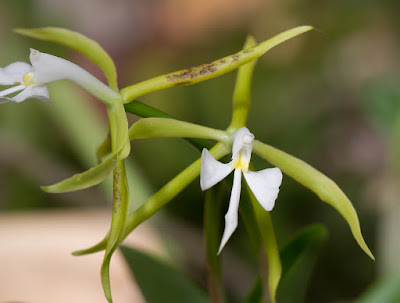Epidendrum oerstedii is endemic to Central America. It occurs in Costa Rica, Honduras, Nicaragua and Panama. It grows in tropical dry forest, transitional forests and moist montane forests. It has also been collected in pastures with scattered clumps of trees with abundant epiphytes. This orchid grows at elevations from 50 to 1600 m in five ecoregions: the Central American Atlantic Moist Forests, Central American Dry Forests, Central American Pine Oak Forests, Costa Rican Seasonal Moist Forests and Isthmian Pacific Moist Forests...
Epidendrum oerstedii also called as Oersted's Epidendrum, Coilostylis oerstedii, Epidendrum costaricense, Epidendrum cilare var oerstedii, Epidendrum umlauftii, is a species of the genus Epidendrum. This species was described by Heinrich Gustav Reichenbach in 1852.
IDENTIFY EPIDENDRUM OERSTEDII ORCHID PLANT
Epidendrum oerstedii is endemic to Central America. It occurs in Costa Rica, Honduras, Nicaragua and Panama. It grows in tropical dry forest, transitional forests and moist montane forests. It has also been collected in pastures with scattered clumps of trees with abundant epiphytes. This orchid grows at elevations from 50 to 1600 m in five ecoregions: the Central American Atlantic Moist Forests, Central American Dry Forests, Central American Pine Oak Forests, Costa Rican Seasonal Moist Forests and Isthmian Pacific Moist Forests.
It is a small sized, erect, warm to cool growing epiphytic plant with a creeping, terete rhizome carrying an erect, that has the upper 2 internodes swollen and flattened to form a fusiform, 7 to 15 cm long pseudobulb with scarious, imbricate, acuminate, evanescent sheaths in youth that can become shallowly grooved with age and carrying divergent, slightly recurved, elliptic or oblong-elliptic, rounded or somewhat retuse apically, dark green, 7-16 cm long and 3-5 cm wide leaves.
Oersted's Epidendrum flowers in the spring through summer on an apical, short to 12 cm long, 2 to 3 flowered, racemose inflorescence arising on a newly forming pseudobulb that has a basal green sheath and simultaneously opening flowers. The flowers are 7.5 cm in diameter. Petals and sepals in their shape are the same with one small difference, that the petals are slightly narrower, 5-7 cm long and 0.5 cm wide, with pointed tips. Sepals slightly concave, yellow-green. The lip is triple, white, fused along the entire length with the column, its lateral parts are wide.
EPIDENDRUM OERSTEDII ORCHID PLANT CARE AND CULTURE
Cultural information should only be used as a guide, and should be to be adapted to suit you. Your physical location; where you grow your plants, how much time you have to devote to their care, and many other factors, will need to be taken into account. Only then can you decide on the cultural methods that best suit you and your plants.
Light:
Epidendrum oerstedii loves bright sunlight and is able to tolerate direct morning and evening sun, however, in the hot summer noon (especially in the windows of southern orientation), the orchid should be protected from direct sunlight: put behind a curtain (for example, on a table near a window) or in the shade of other plants, otherwise the plant can get a sunburn.
Temperature:
This type of orchid refers to a moderate temperature regime, and throughout the year the orchids are grown under the following conditions: Day temperature is not above 25 ° C; Night temperature at 15-20 ° C. For the successful cultivation at home, it is necessary that the night temperature of the content is always 5 ° C lower than the daytime temperature.
Humidity:
For normal growth and development Oersted's Epidendrum need the humidity of 50-70%. Too dry air negatively affects the development of the plant and its growth is inhibited.
Substrate, growing media and repotting:
Epidendrum oerstedii can be grow in pot, basket or placed on blocks. As a substrate, the mixture of the bark of coniferous trees with peat, moss sphagnum and charcoal is best. When growing orchids on blocks, it is recommended to cover the roots of the plant with moss, which will be a good protection against very rapid drying.
Watering:
In the period from March to November, this species requires frequent and abundant watering. Excess water during watering should flow freely out of the pot, as the stagnation of water both inside the pot and in its pan can very quickly lead to decay of the roots and the lower part of the plant. The substrate between waterings should dry well.
Fertilizer:
During the whole year, this type of orchid is fertilized every 2-3 weeks in the usual fertilizer concentration indicated on the package.
Rest period:
In natural habitats, Epidendrum oerstedii undergoes a winter period of rest every year, which is expressed by the fact that plants are kept at a temperature of 15-18 ° C from mid-November, and very little watered. Watering the orchids should be coordinated at relatively lower temperatures and produced no more often than once in 2-3 weeks. With increasing daylight hours in March, the rest period ends: the total temperature of the content rises, and watering is carried out in the usual volume.















COMMENTS